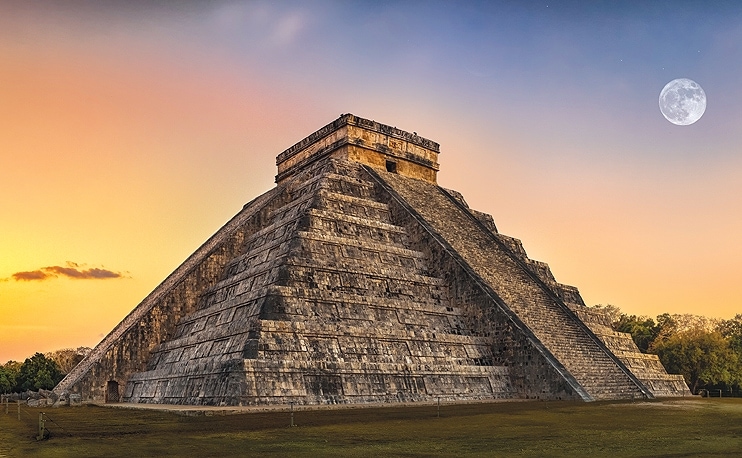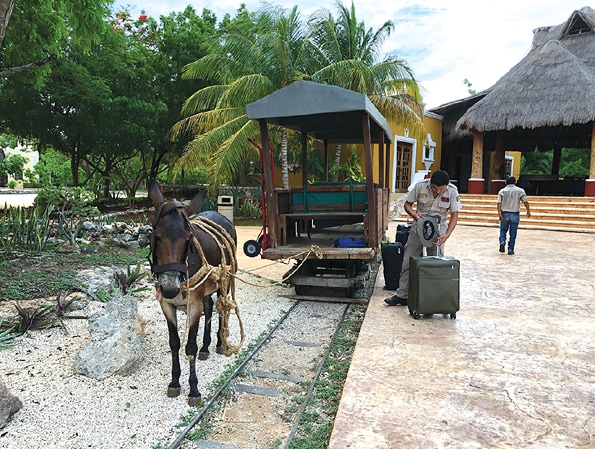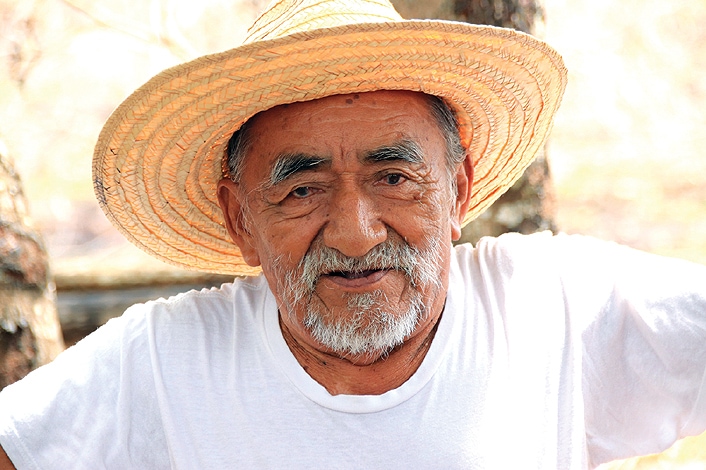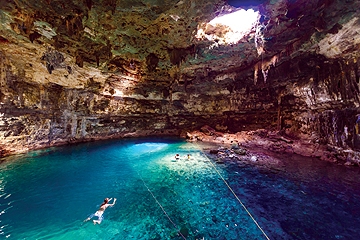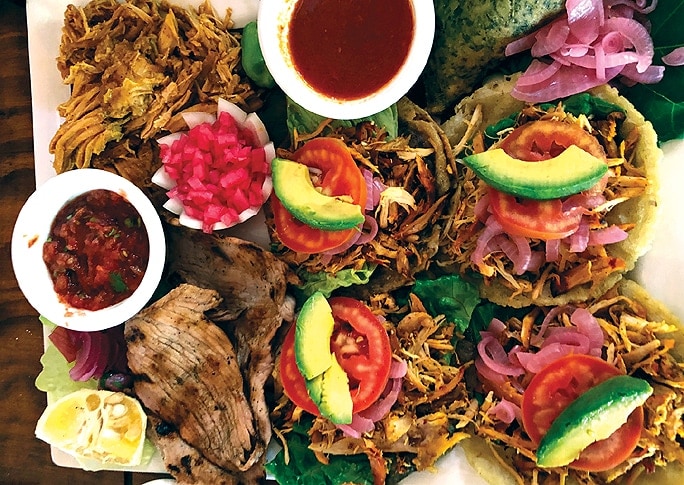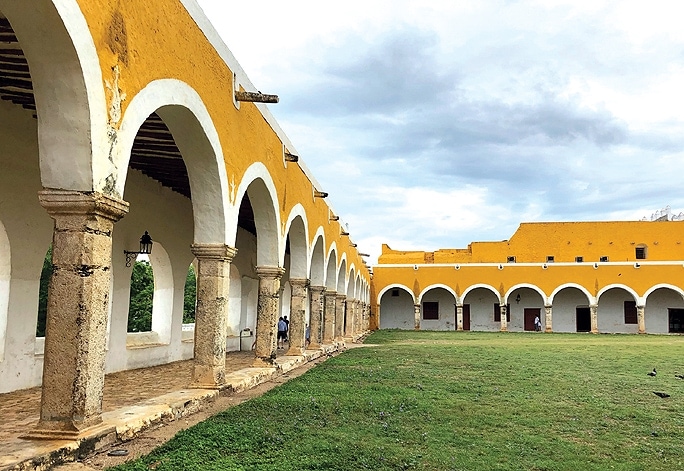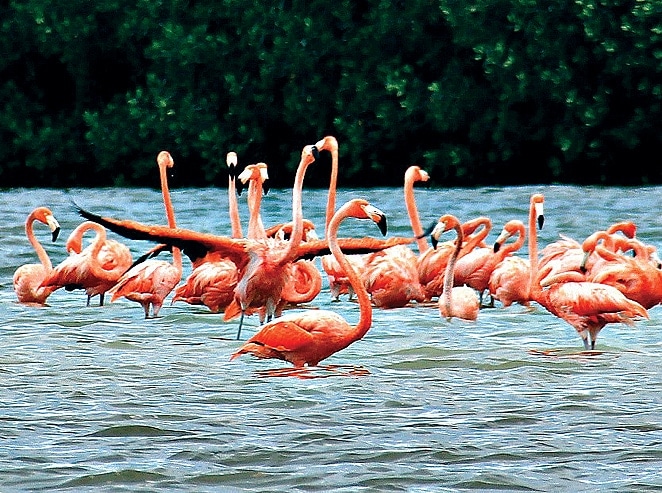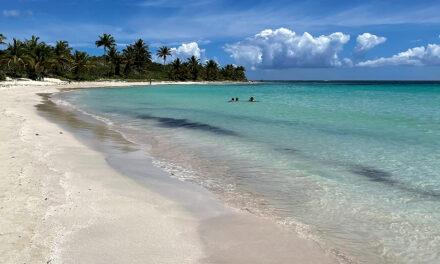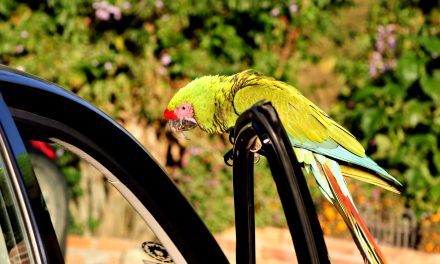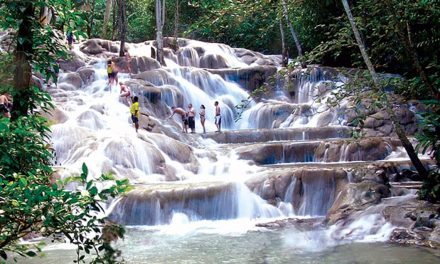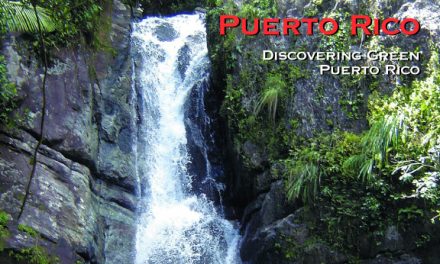Mexico
Mexico’s Magical Yucatan State
Article and photography by Steve Gillick
When we arrived at the Sotuta de Peón, a Hacienda Hotel located about one hour south of the Yucatan State capital city of Merida, the porter immediately went off to a nearby field of sisal plants and palm trees. There, he bridled the sole donkey who was quietly enjoying the shade, and hitched him to a wagon that would carry us and our luggage to our assigned bungalows. The wagon’s railroad wheels followed the tracks that ran through the property; an homage to the transportation used in the mid-19th century when sisal represented the chief economic resource and was known as ‘the green god of the Yucatan’.
The next day we met Ivan, our guide for a walking tour of Hacienda history. With an endearing, animated style, Ivan explained that the name of the property ‘Sotuta de Peón’, derived from the Mayan expression ‘So To Teh HA!’ (and we all jumped back as Ivan yelled out the word “HA”). “’HA’ means water, so the expression translates as ‘water that circulates’, and you must emphasize the ‘HA’ with a strong voice’’. Ivan explained that ‘water’ referred to the eight inter-connected cenotes on the property. Cenotes are one of the hallmarks of the Yucatan area and denote surface pools connected to a subterranean water source that is usually exposed when a limestone structure, for example, a cave, collapses. The Yucatan boasts 3000 of Mexico’s 6000 cenotes and as Ivan explained, “each one is different”.
The fascinating Hacienda tour covered the large plantation home of Augusto Peón, the patriarch of the family, and included an interactive walk through the rope production process. The tour ended when a wagon, drawn by a horse this time, took us to one of the cenotes for photos, a swim and a visit to the outdoor bar for a taste of a refreshing, lemony Margarita made with Mezcal, an agave-based liquor, somewhat similar to Tequila.
The Hacienda visit was yet another confirmation of the unique nature of the Yucatan and the amazing finds that travelers can discover. Still, many people tend to confuse Yucatan State with the Yucatan Peninsula that encompasses the three States of Yucatan, Quintana Roo (including Cancun, Cozumel, Isla Mujeres, Playa del Carmen, Xcaret, etc.) and Compeche (including the walled city of Compeche and the jungle city of Calakmul, etc). Chichen Itza, the Mayan complex located in Yucatan State is often assumed to be the only attraction of value in the State, so it’s time to set the record straight!
From Cancan Airport, our van drove two-hours on the well-maintained highway to Valladolid, one of Mexico’s 122 Magical Towns. A committee of the Secretariat of Tourism designates ‘magical experiences’ based on a number of criteria that include natural beauty, cultural richness, traditions, crafts, food, festivals, exceptional hospitality, and more.
We stayed at the Hostería del Marqués, a converted 17th century home filled with beautiful antiques. Morning coffee by the small outdoor pool was followed by breakfast in the restaurant that surrounds a peaceful treed courtyard. The hotel is only a short walk to the town square with the impressive Church of San Servacio, dating to 1706, and the Municipal Palace where murals relate how Valladolid earned the nickname “The Heroic City”.
One of the main attractions a bit further afield is the 16th century Convento de San Bernardino de Siena. Here visitors can pose with the colorful Valladolid tourist sign amidst bright red “Flamboyant” trees. A second popular attraction is the Cenote Zaci, the cenote of the White Sparrow Hawk, complete with a small waterfall, stalactites and stairs that take you to the pool of blue-green water.
Izamal is another designated Magical Town. It’s unofficially known as the Yellow City based on the color of many historic buildings in the downtown core, and when you enter that area, the common reaction is “Oh my goodness, I had no idea”. The town is stunning. The most visited attraction is the Franciscan Convent of San Antonio de Padua, which was completed in 1549 and built from, and over, Ppapp-Hol-Chac, a major Mayan temple. From the arcades of the convent, you can see hills where other Mayan temples were located, as well as Kinich Kakmo, the 35 meter (115 feet) temple/pyramid dedicated to the goddess of the sun and fertility. Many visitors hire a horse (wearing a flowered hat) and buggy to tour the city, but it is very walkable with gorgeous colonial houses, shops, restaurants and those brilliant red Flamboyant trees everywhere.
After a fairly easy climb to see the panoramic town views from the top of the pyramid, we headed to Restaurant Zamna. As the majority of Izamal’s population of 15,000 have Mayan-Mixtes roots, this is a great city for foodies. We sipped our Chaya cocktail, made with a spinach-like local vegetable as the savoury dishes arrived: Salbute (puffed deep fried tortilla with pulled turkey, okra, tomato and onion), Panucho (a refried tortilla stuffed with black beans, meat and vegetables) and Longaniza (smoked pork sausage with ashiote). So good!
After an overnight stay and tour of Hacienda Sotuta de Peón, we continued to the city of Merida. Our hotel, Casa del Balam, was only a few blocks from Plaza Mayor, which on a Sunday afternoon, was an eyeful of colour, with crowds strolling the streets and shops, visiting the food and souvenir vendors, and gazing at the architectural wonders that surround the Plaza. This includes the amazing 1540 façade of Montejo’s House, the Merida Cathedral (completed in 1598, making it the oldest mainland Cathedral in the Americas), the Governor’s Palace (filled with historical paintings and murals), and the city hall crowned by a Moorish-inspired blue and gold cupola.
That evening we joined Miguel Andres Hernandez, the Vice Minister of Tourism for the State of Yucatan for a celebration of Mexican flavours at Apoala, one of the top restaurants in Parque de Santa Lucia. As we sampled corn empanadas with black mole, and octopus ceviche with scallops, Hernandez noted that Yucatan State is one of the safest places in Mexico, ‘We don’t even have aggressive merchants here!” He noted that many Yucatecos (people of the Yucatan) love to engage visitors with stories about their family history, something that added to the total Yucatan travel experience of nature, beaches, forests, music, cenotes, culture and gastronomy. He stated that “The quality of the travel experience is very high in the Yucatan and besides, we have great weather”.
The next afternoon we came face-to face with nature on our boat trip through the Celestún Biosphere Reserve. We encountered a field of Pink Flamingoes, trees full of nesting Magnificent Frigate birds and Cormorants, and a thrilling ride through the mangroves.
The final night of our trip was spent at the Mayaland Hotel, directly connected by a short walking path to the Mayan complex of Chichen Itza. At 5:00 am, with the help of our guide’s super-bright flashlight, we toured the ancient Mayan complex and then, with less than a dozen people present, watched the sunrise by the Temple of Kukulcan. The experience was memorable.
Yucatan State is one of those magical places, complete with Magical Towns, where travellers can enjoy a fulfilling interaction with the destination. The take-away is sheer enjoyment along with that sometimes-illusive travel feeling of “Wow”.
www.yucatan.travel

